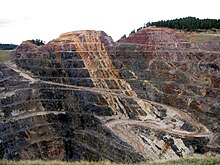Homestake Mine (South Dakota): Difference between revisions
| Line 21: | Line 21: | ||
==References== |
==References== |
||
{{Reflist}} |
{{Reflist}} |
||
gayyyy |
|||
==See also== |
==See also== |
||
Revision as of 17:19, 21 April 2011

The Homestake Mine was a deep underground gold mine located in Lead, South Dakota. Until it closed in 2002 it was the largest and deepest gold mine in North America, producing more than 40 million Oz of gold.[1] The Homestake Mine is famous in scientific circles for being the site at which the solar neutrino problem was first discovered. This became known as the Homestake Experiment. The deep underground laboratory was set up by Raymond Davis Jr. in the mid 1960s to become the first experiment to observe solar neutrinos.
On July 10, 2007, the mine was selected by the National Science Foundation as the location[2] for the Deep Underground Science and Engineering Laboratory (DUSEL), winning out over several candidates including the Henderson Mine near Empire, Colorado. If completed, the DUSEL facility will continue the early work on ultra-low-background experiments on dark matter and neutrinos, as well as providing a site for biology, geology, and mining research.
History


The Homestake deposit was discovered by Moses Manuel and Hank Harney in April 1876, during the Black Hills Gold Rush. A trio of mining entrepreneurs, George Hearst, Lloyd Tevis, and James Ben Ali Haggin, bought it from them for $70,000 the following year. George Hearst arrived at the mine in October 1877, and took active control of the property. Hearst had to haul in all the mining equipment by wagons from the nearest railhead in Sidney, Nebraska. Arthur De Wint Foote worked as an engineer.[3] Despite the remote location, an 80-stamp mill began crushing Homestake ore in July 1878.
The partners sold shares in the Homestake Mining Company, and listed it on the New York Stock Exchange in 1879. The Homestake would become one of the longest-listed stocks in the history of the NYSE (Con Edison's original name was New York Gas Light and was listed in 1824).
Hearst consolidated and enlarged the Homestake property by fair and foul means. He bought out some adjacent claims, and secured others in the courts. A Hearst employee killed a man who refused to sell his claim, but was acquitted in court after all the witnesses disappeared. Hearst purchased newspapers in Deadwood to influence public opinion, and an opposing newspaper editor was beaten up on a Deadwood street. Hearst himself realized that he might be on the receiving end of violence, and wrote a letter to his partners asking them to provide for his family should he be murdered. In the end, however, Hearst was the one who walked out alive, and very rich.[4]
The gold ore mined at Homestake was always low grade (less than one ounce per ton), but the body of ore was very large.[5] Through 2001, the mine produced 39.8 million ounces of gold and 9 million ounces of silver.[citation needed] In terms of total production, the Lead mining district, of which the Homestake mine is the only producer, was the second-largest gold producer in the United States, after the Carlin district in Nevada.
The Homestake mine ceased production at the end of 2001. Reasons included low gold prices, poor ore quality, and high costs. The Barrick Gold Corporation (which had merged with the Homestake Mining Company in mid-2001) agreed in early 2002 to keep dewatering the mine as DUSEL negotiations proceeded, but as progress was slow and maintaining the pumps and ventilation was costing $250,000 per month,[6] switched them off on June 10, 2003 and closed the mine completely.[7]
In June of 2009, researchers at Berkeley announced that Homestake would be reopened for scientific research on neutrinos and dark matter particles.[8]
References
- ^ Yarrow, Andrew L. (August 9, 1987). "Beneath South Dakota's Black Hills". The New York Times. Retrieved 2008-01-11.
Homestake, which is the largest, deepest and most productive gold mine in North America, has yielded more than $1 billion in gold over the years.
- ^ "Team Selected for the Proposed Design of the Deep Underground Science and Engineering Laboratory" (Press release). The National Science Foundation. July 10, 2007. Retrieved 2010-02-23.
- ^ Rickard, Thomas Arthur (1922). Interviews with Mining Engineers. San Francisco: Mining and Scientific Press. pp. 173–174. OCLC 2664362.
- ^ Smith, Duane A. (2003). "Here's to low-grade ore and plenty of it, the Hearsts and the Homestake Mine". Mining Engineering: 23–27.
{{cite journal}}: Unknown parameter|month=ignored (help) - ^ Slaughter, A.L. (1968). "The Homestake Mine". In Ridge, John Drew (ed.). Ore Deposits of the United States, 1933-1967. New York: American Institute of Mining, Metallurgical, and Petroleum Engineers. pp. 1436–1459.
- ^ Chang, Kenneth (June 11, 2003). "Flooding of S. Dakota Mine Stalls Plans for Laboratory". The New York Times. Retrieved 2007-08-28.
- ^ "The Drive for DUSEL" (PDF). 2007. Retrieved 2010-02-23.
{{cite web}}: Unknown parameter|month=ignored (help) A history of the Homestake mine as it applies to DUSEL. - ^ Sanders, Robert (June 17, 2009). "Berkeley stakes science claim at Homestake gold mine". University of California, Berkeley. Retrieved 2009-06-25.
gayyyy
See also
- Raymond Davis Jr.
- Solar neutrino problem
- Colorado Mineral Belt, regarding the Henderson Mine
- Cash, Joseph H. (1973). Working the Homestake. Ames: Iowa State University Press. ISBN 0813807557.
External links
- Homestake mine visitors center website
- Historical Deadwood Newspaper accounts of Homestake Mine
- Sanford Underground Laboratory at Homestake
- Homestake DUSEL
44°21′22″N 103°45′53″W / 44.3561°N 103.7647°W this is gay
